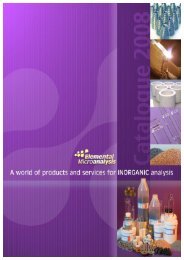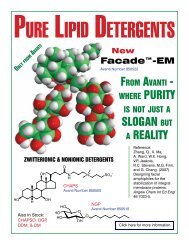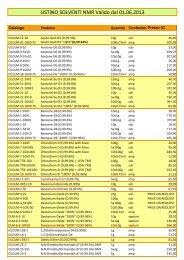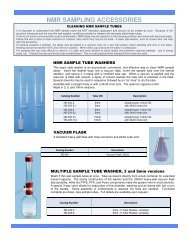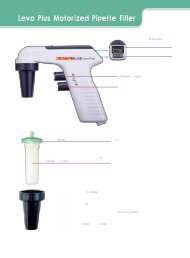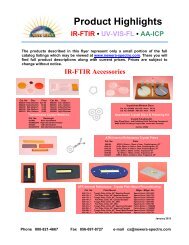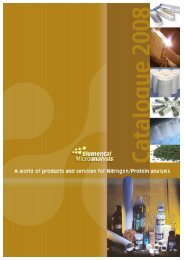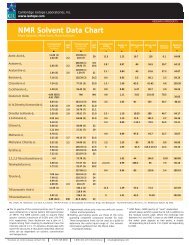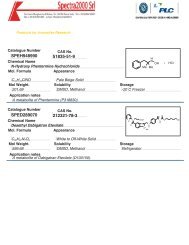specialty nmr sample tubes - Spectra 2000 Srl
specialty nmr sample tubes - Spectra 2000 Srl
specialty nmr sample tubes - Spectra 2000 Srl
Create successful ePaper yourself
Turn your PDF publications into a flip-book with our unique Google optimized e-Paper software.
SPECIALTYNMR SAMPLE TUBESLIGHT SENSITIVE SAMPLE TUBESFor containment of NMR <strong>sample</strong>s that aresensitive to light. Constructed from Pyrex glass,the <strong>tubes</strong> are subjected to a high temperature ionexchange reaction to impart the light blockingproperties to the glass surfaces.In order to form stronger bonding, a specialoptical coating technique is used (as opposed tothe usual amberization of other <strong>tubes</strong> found onthe market). A maximum blocking per centresults for wavelengths
SPECIALTYNMR SAMPLE TUBESCONTROLLED ATMOSPHERE VALVE (CAV) SAMPLE TUBEA linear valve system for performing controlled atmosphere experiments by NMR. The concentric valve mechanism consists of asturdy, precision machined TFE plug with a Viton o-ring seal. A glass vacuum adapter is supplied with each system. It is secured tothe top of the valve with a press fit sealed by an o-ring.Application Note:To use the CAV, the glass adapter is first secured to the vacuum line. With the valve attached and in the open position,vacuum transfers can be made to and from the <strong>sample</strong> tube. Once the proper <strong>sample</strong> environment is attained, the valve canbe closed and the system can be removed from the vacuum line. The process is repeated to retrieve the <strong>sample</strong>.This system is very useful in the study of organometallics or other moisture and air sensitive <strong>sample</strong>s.Note: It is not recommended to use ketones, aldehydes, ethers or aliphatic esters with Viton rubber.Aegis o-rings are available for use with these compound types (see below) and must be ordered separately.Note: To the catalog number, add the length “L” (XXX), in mm, that places the valve directly on top of thespinner. This is necessary to maintain good spinning quality. Example: NE-CAV-170 indicates L=170mm.Catalog NumberSample TubePRESSURE VALVE (PCAV) SAMPLE TUBEConstructed as the CAV Sample Tube above; except, the PCAV Sample Tube allows for easy connection to agas manifold with a nut and ferrule for 1/16” tubing. The extended plug tip gives finer control of flow. When thevalve is completely closed, the gas line is easily disconnected from the top of the valve body. The system hasbeen successfully tested to 20 atmospheres with the 5mm medium-wall tube.Individual results may vary and cannot be guaranteed.The above “Notes” also apply here for o-ring chemical compatability and the “L” Dimension.Wall(mm)UsageMHzNE‐CAV5‐XXX NE‐HP5 0.38 400‐500NE‐CAV5‐M‐XXX NE‐HP5‐M 0.77 300‐400NE‐CAV5‐H‐XXX NE‐HP5‐H 1.4 300‐400NE‐CAV10‐XXX NE‐H10 0.46 300‐500NE‐CAV10‐M‐XXX NE‐H10‐MW 1.00 300‐400NE‐CAV10‐H‐XXX NE‐H10‐HW 1.7 300‐400NE‐CAV5‐Q‐XXX NE‐HQ5 0.50 300‐500NE‐CAV10‐Q‐XXX NE‐HQ10 0.50 300‐500Catalog NumberSample TubeWall(mm)UsageMHzNE‐PCAV5‐XXX NE‐HP5 0.38 400‐500NE‐PCAV5‐M‐XXX NE‐HP5‐M 0.77 300‐400NE‐PCAV5‐H‐XXX NE‐HP5‐H 1.4 300‐400NE‐PCAV10‐XXX NE‐H10 0.46 300‐500NE‐PCAV10‐M‐XXX NE‐H10‐MW 1.00 300‐400NE‐PCAV10‐H‐XXX NE‐H10‐HW 1.7 300‐400CAV / PCAV Spare PartsTop of PCAVCatalog Number Description Price / Tube eachCatalog Number Description Tube1-9 10+NE‐CAV5‐G‐XXX NE-CAV5-G-XXX Valve Valve Body, Body, only, only, Thin-Wall Thin‐Wall Tube Tube CAV, PCAV $ 56.85 CAV, $ PCAV 52.85NE‐CAV5‐M‐G‐XXX NE-CAV5-M-G-XXX Valve Valve Body, Body, only, only, Medium-Wall Medium‐Wall Tube Tube CAV, PCAV 58.35 CAV, PCAV 54.35NE‐CAV5‐H‐G‐XXX NE-CAV5-H-G-XXX Valve Valve Body, Body, only, only, Heavy-Wall Heavy‐Wall Tube Tube CAV, PCAV 64.35 CAV, PCAV 60.35NE‐CAV‐P NE-CAV-P Plug, Plug, TFE TFE with with knob knob and and sealing sealing O-ring O‐ring CAV $ 47.10 CAVNE‐PCAV‐P NE-PCAV-P Plug, Plug, TFE TFE with with knob, knob, o-rings o‐rings and and fittings fittings PCAV 63.00 PCAVNE‐CAV‐SO NE-CAV-SO Sealing Sealing O-ring, O‐ring, Viton Viton CAV, PCAV CAV, 2.40 PCAVNE‐CAV‐SO‐A NE-CAV-SO-A Sealing Sealing O-ring, O‐ring, Aegis Aegis CAV, PCAV 34.50 CAV, PCAVNE‐CAV‐RO NE-CAV-RO Retaining Retaining O-ring, O‐ring, Viton, Viton, retain to retain valve valve knob knob CAV, PCAV CAV, 2.40 PCAVNE‐CAV‐RO‐A NE-CAV-RO-A Retaining Retaining O-ring, O‐ring, Aegis, Aegis, to to retain retain valve valve knob CAV, PCAV 34.50 CAV, PCAVNE‐CAV‐A NE-CAV-A Adapter, Adapter, only, only, glass glass CAV 10.90 CAVNE‐CAV‐JA NE-CAV-JA Adapter, Adapter, with with 24/40 24/40 outer outer joint, joint, glass glass CAV 29.35 CAVNE‐PCAV‐FN NE-PCAV-FN Ferrule/Nut Ferrule/Nut Set, Set, one one ferrule ferrule and and one one nut nut PCAV 8.95 PCAVReferences:Constrained Geometry Chromium Catalysts for Olefin Polymerization; Y. Liang, G.P.A. Yap, A.L. Rheingold, K.H. Theopold,Organometallics 1996, 15, 5284[(Ph)2 nacnac]MCl2(THF)2 (M=Ti, V, Cr)-- A New Class of Homogeneous Olefin Polymerization Catalysts Featuring β-Diiminate Ligands,W.K. Kim, M.J. Fevola, L.M. Liable-Sands, A.L. Rheingold, K.H. Theopold Organometallics 1998, 17, 4541NE-CAV-ANE-CAV-JA
SPECIALTYNMR SAMPLE TUBESGEL NMR SAMPLE TUBES and ACCESSORIESThe Gel Apparatus and accessories are designed for RDC studies of uniformly aligned proteins and detergentmicells by NMR. The precision Gel Chamber casts consistently uniform gels. Samples can then be uniformlystretched, with repeatability, and loaded into the active area of the <strong>sample</strong> tube, assuring maximum <strong>sample</strong>concentration in the coil. The precision of the apparatus will give repeatable <strong>sample</strong> conditions.The accessories described here are designed for forming and stretching gel <strong>sample</strong>s of 6mm, 5.4mm and 5mmdiameter to the 4.2mm ID of the <strong>sample</strong> tube as it is being loaded into the tube. All hardware components areeasily cleaned and are reusable.GEL KITSThese kits are designed for the first-time user and provide all of the hardware itemsneeded to cast and stretch the <strong>sample</strong>s. For the science of RDC measurements asrelated to gels and proteins, one must search the many papers available, only a fewof which are cited on Page 18. Additional and replacement components are allavailable separately.Gel NMR Starter Kits(includes a gel press assembly, all plugs and accessories, and a special gel NMR <strong>sample</strong> tube)Add “-Br” suffix to Cat. Nos. for Bruker that requires a short end plug (8mm Length).Gel Gel Diameter 500 MHz MHz 700 MHz 900+ 900+ MHz MHz6mm to 4.2mm6mm 5.4mm to 4.2mm to 5.4mm 5mm to to 4.2mm 4.2mmCat. No.Cat. Cat. No. No.Cat. Cat. No. No.NE-373-A-6/4.2NE‐373‐A‐6/4.2NE-373-A-5.4/4.2NE‐373‐A‐5.4/4.2NE-373-A-5/4.2NE-373-B-6/4.2NE-373-B-5.4/4.2NE‐373‐B‐6/4.2NE‐373‐B‐5.4/4.2NE-373-B-5/4.2NE-373-C-6/4.2NE-373-C-5.4/4.2NE‐373‐C‐6/4.2NE-373-C-5/4.2NE‐373‐C‐5.4/4.25mm to 4.2mm Price / each Cat. No. NE‐373‐A‐5/4.2 $ 395.00 NE‐373‐B‐5/4.2$ 398.00 NE‐373‐C‐5/4.2$ 405.00Additional / Replacement PartsSample Tubes500 MHz 700 MHz 900+ MHzCat. No. NE‐HP5‐GT‐7 NE‐UP5‐GT‐7 NE‐SP5‐GT‐7Plugs and Accessories (for all Starter Kits)NE‐370‐A‐5NE‐370‐A‐5‐SNE‐370‐A‐5‐ONE‐370‐B‐5NE‐371NE‐341‐5NE‐312‐5‐GTCatalog NumberDescriptionGel End Plug, UltemGel End Plug, Ultem, ShortGel End Plug Spare O‐Ring, Buna‐NGel Top Plug, UltemExtraction Rod, for end plugSupport Rod, Kel‐F, for top plugSupport Cap, PTFE
SPECIALTYNMR SAMPLE TUBESGEL PRESSES and ADDITIONAL / REPLACEMENT COMPONENTSSome operational suggestions to help getting startedThe gel press should be assembled as shown in the sketch. Please note that thearrow on the body of the Gel Chamber must point downward towards the thread of theFunnel. This will provide a smooth transition through which the gel will pass.It is also suggested that several “gel only” <strong>sample</strong>s be tried first to get the feel of howthe press will operate.It is very important that the Gel <strong>sample</strong> tube be oriented in the correct way. Since bothends of this tube are opened, the “bottom end” with the special finish is opposite to thecatalog mark on the tube. This is the end that must be inserted into the bottom of theFunnel. The special end finish is necessary to allow the End Plug to seal the tubewithout breaking it.Gel Presses(includes piston driver, cap, piston, gel chamber and funnel)Size 6mm to 4.2mm 5.4mm to 4.2mm 5mm to 4.2mmCat. No. NE‐372‐6/4.2 NE‐372‐5.4/4.2 NE‐372‐5/4.2Additional / Replacement PartsPistons, PTFE, w/Buna O-RingSize 6mm to 4.2mm 5.4mm to 4.2mm 5mm to 4.2mmCat. No. NE‐372‐C‐6 NE‐372‐C‐5.4 NE‐372‐C‐5Piston Spare O-Rings, Buna-NCat. No. NE‐372‐C‐6‐O NE‐372‐C‐5.4‐O NE‐372‐C‐5‐OGel Chambers, PTFESize 6mm to 4.2mm 5.4mm to 4.2mm 5mm to 4.2mmCat. No. NE‐372‐D‐6 NE‐372‐D‐5.4 NE‐372‐D‐5Funnels, PTFESize 6mm to 4.2mm 5.4mm to 4.2mm 5mm to 4.2mmCat. No. NE‐372‐E‐6 ‐ ‐Cat. No. ‐ NE‐372‐E‐5.4 NE‐372‐E‐5Piston Driver and Cap(for all Gel Presses)Cat. No.NE‐372‐ANE‐372‐BDescriptionPiston Driver, BrassCap, Brass
SPECIALTYNMR SAMPLE TUBESSome Reflection on Gel NMR Sample PreparationThe information presented below is intended to be used as a guide in developing yourprocedure and not as a set of specific instructions. A technique needs to be developedby the user that works best, and the first attempt will be a learning experience.What stretch ratio can give the optimal size of RDC?Version 6 to 4.2mm: works well with proteins like protein G.Version 5.4 to 4.2mm: generally good for strong aligning proteins.Version 5 to 4.2mm: generally good for proteins that are both large and elongated.Experimentation with different stretch ratios may be necessary to determine which one is best for the<strong>sample</strong>s at hand.Allow 2-3 days for complete <strong>sample</strong> preparation.Some gel solutions may be basic and/or contain unreacted components which could affect the stability of theprotein if it were added to the initial solution.Approximately 250µl of gel solution would make a <strong>sample</strong> column height of about 20mm.Assuming protein has not been added, seal the bottom of the Gel Chamber (parafilm) and fill with gel solution.Allow to polymerize for at least 1-2 hours. The seal (parafilm) can then be taken off the chamber.Carefully remove the gel with the use of the Piston and an appropriate tool for pushing it through the chamber.Be careful not to scratch the inner surface of the chamber.Dialyze the gel against deionized water overnight to remove unreacted chemicals.While the gel is still soft, it may be cut to some appropriate length. Allow for the length of the Piston and forsome air space between it and the surface of the gel.As a guide line, the gel length should be about ⅓ the length of the Gel Chamber allowing room for an air spaceand the Piston. The air space will allow more of the gel to be expelled.Dry overnight at room temperature or for some hours at an elevated temperature (40-45 o C). The gel willbecome somewhat rigid and smaller in diameter.Place the “dried” gel back into the Gel Chamber, seal the bottom (parafilm) and add protein until the gel swellsto the full diameter of the chamber. Let it sit for 24 hours or longer to allow the protein to diffuse in.Remove any excess protein that has not been diffused into the gel.Assemble the Gel Press and load the gel into the <strong>sample</strong> tube.The Piston will only go as far as the top of the actual funnel area which may still contain some gel. With theGel Chamber removed from the Funnel, the action of an auto-pipet may be used to apply enough air pressureto expel the remaining gel.Seal the bottom of the <strong>sample</strong> tube by gently pressing the Gel End Plug in to place, in such a manneras to avoid trapped air bubbles (the Extraction Rod is used only to remove the Gel End Plug from the<strong>sample</strong> tube).Insert the Gel Top Plug on top of the gel column with the Support Rod.Ideally, the <strong>sample</strong> column should be centered in the receiver coil area. It may take a few trials to find theoptimum <strong>sample</strong> position for this application in the probe.Some references:Bax, A. Tjandra, N. (1997) J. Biomol. NMR, 10, 289-292Chou, J.J., Li, S., Klee, C.B. and Bax, A. (2001) Nat. Struct. Biol., 8, 990-997Chou, J.J., Gaemers, S., Howder, B., Louis, J.M. and Bax, A. (2001) J. Biomol. NMR, 21, 377-382Tycko, R., Blanco, F.J. and Ishii, Y. (<strong>2000</strong>) J. Am. Chem. Soc., 122, 9340-9341
SPECIALTYNMR SAMPLE TUBESTIP-OFF SEALING SYSTEMS APPLICATION NOTESFLAME-SEALING NMR SAMPLE TUBES:There are two basic ways to prepare flame-sealed <strong>sample</strong>s. One method, suitable for both Pyrex and non-Pyrex <strong>tubes</strong>, is touse a “vacuum adapter” to attach the tube to the vacuum line via a hose or other mechanical means. Sample <strong>tubes</strong> are held inplace by an o-ring compressed finger tight by a threaded bushing.The second way, for Pyrex <strong>tubes</strong> only, starts with “flame-sealing the <strong>sample</strong> tube” to the port on the vacuum line. Althoughmore difficult to attain a good seal, this method ensures the integrity of the <strong>sample</strong> system and allows for vacuum transfersunder very controlled conditions. Many researchers, adept at glassblowing, prefer this method.FLAME-SEALING TECHNIQUES:Hand-held micro torches (available from major lab supply dealers) provide a small, yet very hot, flame to easily seal <strong>tubes</strong>.A very uniform, concentric seal is important to maintain good spinning quality. The way to accomplish this is by heating theglass evenly around the tube. The best seals are made with pre-constricted <strong>tubes</strong>. Increased glass thickness in the seal areareduces the chance of the hot glass imploding due to the vacuum in the tube. It is important that only the seal area be heated.Finally, the key to making good seals is practice.FREEZE / THAW DEGASSING:This method is often used to remove Oxygen from <strong>sample</strong>s. However, with aqueous <strong>sample</strong>s, it can be difficult to complete theprocess without breaking the tube. One effective technique is as follows: Once the <strong>sample</strong> is loaded and the tube is securedunder vacuum, immerse the tube into the freezing medium (liquid N 2 , dry ice/alcohol) very slowly so that the <strong>sample</strong> freezesfrom the bottom, up. Likewise, in the thaw cycle, remove the tube very slowly so that the <strong>sample</strong> melts from the top, down.The use of a small cylindrical lab dewar (see Page 20) and a lab jack greatly aid in this process. Some practice isrecommended before valuable <strong>sample</strong>s are used.TIP-OFF SAMPLE TUBESBoth Pyrex and non-Pyrex <strong>tubes</strong> are offered. Pyrex <strong>tubes</strong> are necessary if you need to reopen the tube and do additionalglassblowing. The non-Pyrex <strong>tubes</strong> are ideal for <strong>sample</strong>s that will be archived. In both cases, a 50mm section of 5mm ODtubing is sealed to a 7-inch <strong>sample</strong> tube. The extra tubing allows the tube to be secured in the Tip-Off Adapter (see Page 20)with ample length for safe flame sealing. A uniform constriction, with a 2mm ID, is placed just above the 7-inch length.Catalog NumberUsageTube ODWallMHz(mm)(mm)Glass TypeNE‐HL5‐TTO 400‐500 5 0.38 non‐PyrexNE‐UL5‐TTO 500‐700 5 0.38 non‐PyrexNE‐HP5‐TTO 400‐500 5 0.38 PyrexNE‐HP5‐M‐TTO 300‐400 5 0.77 PyrexNE‐UP5‐TTO 500‐700 5 0.38 PyrexNE‐SP5‐TTO 700‐900+ 5 0.38 PyrexNE‐H10‐TTO 400‐500 10 0.46 Pyrex
ACCESSORIES FOR TIP-OFF SAMPLE TUBESTIP-OFF ADAPTER, basicThe Tip-Off Adapter consists of an internal glass thread with a mating Nylon bushing fitted witha stainless steel heat shield. The shank of the adapter (½” OD x 4” long) is secured to thevacuum manifold. Sample <strong>tubes</strong> are held in place by an extra thick FETFE o-ring compressedby the threaded bushing, finger tight. Tested to 10 -7 Torr.Catalog NumberNE‐250NE‐250‐BNE‐250‐ODescriptionAdapter, complete with one bushing and o‐ringBushing only, with heat shield and two o‐ringsO‐Ring, FETFE, extra thickTIP-OFF ADAPTER / VALVEThe Tip-Off Adapter / Valve features a high vacuum valve with a sturdy Teflon plug and twoTeflon-clad o-rings.The bulbous plug tip makes an inert and positive seal to isolate the vacuum line.The valve has a 0-4mm orifice.The Tip-Off Adapter / Valve can be mounted easily with a clamp to a lab rack.Catalog NumberNE‐253‐5NE‐253‐BNE‐253‐ONE‐253‐GNE‐253‐PDescriptionTip‐Off Adapter / Valve, completeBushing only, Nylon with heat shield and two o‐ringsO‐Ring, FETFE, extra thickGlass Body, onlyTeflon Plug / Cap, onlyTIP-OFF DEWAR and CAPA sturdy Pyrex dewar, fully silvered, with an aluminum base. Measuring 48mm ID x 150mminternal depth, this dewar has a full capacity of 250ml. It is designed for use in the freeze / thawmethod of degassing NMR <strong>sample</strong>s . The large ID allows for easy inspection of the processso that it may be controlled more exactly.An optional styrofoam dewar cap, sold separately, greatly reduces boil-off.Catalog NumberNE‐8025NE‐8348DescriptionDewar, 48mm ID x 150mm depth, 190mm OALCap, styrofoam, with vent slot
SPECIALTYNMR SAMPLE TUBESNON-GLASS SAMPLE CELLSA precision, non-glass <strong>sample</strong> cell for the study of Boron, Fluorine, Silicon and other types of <strong>sample</strong>sthat may be deemed “hazardous”. Available in 5mm and 10mm versions, these precision machined cellsfit smoothly into the respective standard thin wall <strong>sample</strong> <strong>tubes</strong>. A cap, made of the same material,screws into the top of the cell, providing a positive closure and the means for removing the cell with athreaded rod.Boron and Silicon <strong>sample</strong>s can be studied by supporting the cell in a glass sleeve so that only thecell is in the receiver coil area. With the cap secured to the top of the cell, a threaded rod is screwed intothe top of the cap. This unit is slipped through a glass sleeve and is held in place by the support rod witha modified tube cap. Depending on the positioning of the poly cell in the RF coil area, it may bedesirable to cut off excess length of the support rod.Tests with Chloroform-d / TMS <strong>sample</strong>s have shown line widths comparable to using the <strong>sample</strong> tubealone. Some additional shimming may be necessary. Individual results may vary and are dependentupon how well the instrument is tuned. We can offer no guarantee on performance and safety, especiallywith “hazardous” <strong>sample</strong>s.SPECIFICATIONSSample Cell, 5mm version:Sample Cell, 10mm version:Cap, 5mm version:Cap, 10mm version:3.3mm ID x 4.1mm OD x 90mm long, 80mm maximum <strong>sample</strong> height7.5mm ID x 8.9mm OD x 90mm long, 80mm maximum <strong>sample</strong> height20mm long with 4-40 internal thread20mm long with ¼-20 internal threadSAMPLE CELL with CAPCatalog Number Tube OD Material Useful Temp RangeNE‐362‐T‐5NE‐362‐T‐10NE‐362‐K‐5NE‐362‐K‐10NE‐362‐P‐5NE‐362‐P‐10510510510PTFEPTFEKel‐FKel‐FP/PP/P‐73 to +204°C‐73 to +204°C‐240 to +204°C‐240 to +204°C0 to +80°C0 to +80°CVolume @ 60mmSample Height304 µl2.6 ml304 µl2.6 ml304 µl2.6 mlGLASS SLEEVE and SUPPORT RODCatalog NumberNE‐205‐5NE‐205‐10NE‐341‐5NE‐341‐10DescriptionGlass Sleeve, precision, 5mm OD x 120mm longGlass Sleeve, precision, 10mm OD x 120mm longSupport Rod, Kel‐F, ” x 8”, 4‐40 threadSupport Rod, PVC, ¼” x 8”, ¼‐20 threadEXTRA SAMPLE CELLS and CELL CAPSMaterialVersionSample CellCapCat.No.Cat.NoPTFE 5mm NE‐360‐T‐5 NE‐361‐T‐5PTFE 10mm NE‐360‐T‐10 NE‐361‐T‐5Kel‐F 5mm NE‐360‐K‐5 NE‐361‐K‐5Kel‐F 10mm NE‐360‐K‐10 NE‐361‐K‐10P/P 5mm NE‐360‐P‐5 NE‐361‐P‐5P/P 10mm NE‐360‐P‐10 NE‐361‐P‐10
SPECIALTYNMR SAMPLE TUBESCOAXIAL INNER CELLSA precision inner cell for use with 5mm and 10mm thin-wall NMR <strong>tubes</strong>. Ideal for “external” reference solvents or asa “micro tube”. For use with 7” outer <strong>tubes</strong>. Both Bruker and Varian versions are available.Catalog Number Tube / Probe ODNE‐5‐CICNE‐5‐CIC‐VNE‐10‐CICNE‐10‐CIC‐V5mm / Bruker5mm / Varian10mm / Bruker10mm / Varian2mm2mm3mm3mmStemLength50mm60mm50mm60mmCapacity60 µl72 µl225 µl270 µlSample Capacity530 µl636 µl2.8ml3.36mlTEFLON LINERSAn inexpensive way to handle corrosive <strong>sample</strong>s that may react with the glass <strong>sample</strong> tube.The thin wall, round bottom liners are supplied with a Teflon plug closure. For use in standardthin wall 5mm and 10mm <strong>sample</strong> <strong>tubes</strong>. Results may vary and some higher order shimmingmay be necessary. For a precision alternative, see our Non-Glass Sample Cells on Page 21.Catalog Number Tube DescriptionNE‐350‐5 5mm x 7”Round bottom, 8” long with solid Teflon plug;Volume @ 50mm height is @ 0.35mlNE‐350‐10 10mm x 7”Round bottom, 8” long with solid Teflon plug;Volume @ 50mm height is @2.0mlHAZARDOUS NMR SAMPLE TUBE SYSTEMAn effective way to run 5mm NMR <strong>sample</strong>s deemed “hazardous” in some respect. This system wasdesigned to significantly enhance the high field spectral quality, while maintaining a measure of safetyin running these <strong>sample</strong>s. The results have shown a marked improvement over the use of traditionalTeflon liners.A specially designed Teflon plug seals the heavy wall (0.75mm) glass inner tube which then fitscompletely into our NE-HP5-7, 5mm <strong>sample</strong> tube. The inner tube has a <strong>sample</strong> volume of 125µl for a30mm <strong>sample</strong> height. A longer version of the 5mm tube cap seals the system.Once the instrument is shimmed for the <strong>sample</strong> tube system, additional <strong>sample</strong>s can be shimmedeasily. At 500 MHz, spectral quality can be comparable to that of routine <strong>sample</strong>s. Actualperformance will vary and is dependent upon the condition of the instrument. The improved quality ofspectra is a viable trade-off for the careful handling required for such <strong>sample</strong>s. However, there is noexpressed or implied warranty against breakage. An all-Pyrex system, not recommended forFluorides.Catalog Number OD(mm)UsageMHzDescriptionNE‐HP5‐HSTS 5 Up to 500Complete system, inner tube with plug,outer tube with capNE‐HSTS‐I 4 ‐ Inner tube with Teflon plug




